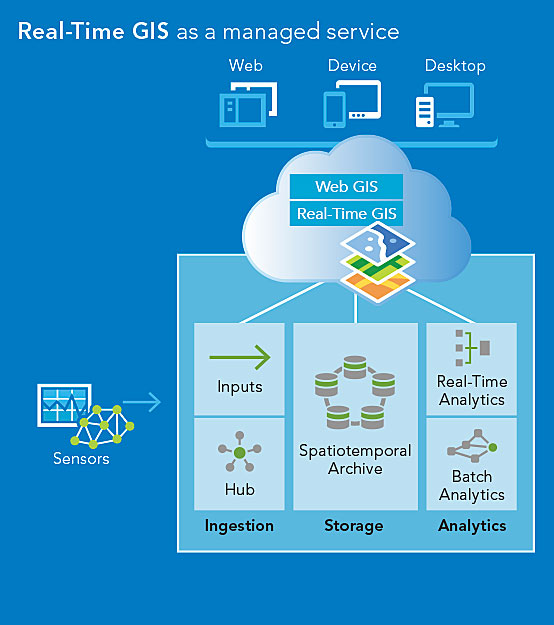Get Ready for the New Real-Time Managed Services
This year, Esri will unveil the next generation of Real-Time GIS. It will enable users to ingest, analyze, and store millions of sensor events per second at scale; rapidly visualize, replay, and explore observations that are in the billions of features; and quickly perform batch analytics on this profusion of information.
Available through Esri Managed Services, this new Real-Time GIS can keep pace with the meteoric rise of the Internet of Things (IoT) and handle any organization’s big data needs.

Connecting with Real-Time Data Streams
Currently, Esri offers Real-Time GIS capabilities via ArcGIS GeoEvent Extension for Server, which can be deployed on-premises or in the cloud. Ready-to-deploy images of ArcGIS for Server—including ArcGIS GeoEvent Extension for Server—are available in the Microsoft Azure and Amazon Web Services marketplaces.
Users employ GeoEvent Extension to connect with real-time data streams, including mobile devices, sensors, in-vehicle GPS devices, and social media providers. It accommodates multiple streams of data flowing continuously through user-defined filters and processing steps that allow clients to focus on only the most important aspects of their operations. It is used to track dynamic assets that are constantly changing location (such as vehicles, aircraft, people, or vessels), as well as stationary assets such as weather and environmental monitoring stations.
Today, GeoEvent Extension is used by hundreds of organizations across numerous industries, including agriculture, government, natural resources, transportation, and utilities.
But with the number of connected devices—and the data created from them—increasing exponentially, big data and the IoT are escalating data scope dramatically, requiring higher and higher data ingestion rates and faster analytics. Whereas on-premises Real-Time GIS can process thousands of events per second (fast enough for many organizations that manage small fleets of vehicles or sensor networks), the new Real-Time GIS service will reliably ingest, process, analyze, and store tens of thousands to several million events per second.
That’s fast enough to support smart cities the size of Los Angeles or London. It’s fast enough to monitor all the sensors and smart meters used by major water, oil, gas, and electric utilities. It can efficiently track and analyze the movement and disposition of large fleets of trucks, ships, and aircraft, which are essentially moving sensor warehouses.
Supporting the IoT’s Vast Quantities of Data
This new managed service for Real-Time GIS has a distributed computing architecture designed to support the volumes of data produced by the emerging constellation of connected devices and sensor technologies that compose the IoT.
The technology will be offered through Esri Managed Services, which provides ready-to-use instances of ArcGIS running in the cloud that can be easily scaled, depending on an organization’s requirements. Users will be able to choose their cloud provider (initially, it will be between Microsoft Azure and Amazon Web Services) and select the geographic region for the cloud deployment.
Real-Time GIS as a managed service leverages multiple aspects of the ArcGIS platform, including web GIS, the Spatiotemporal Big Data Store (which archives real-time observational data), and real-time and batch analytic capabilities. End users will be able to interact with archived data using standard ArcGIS clients, such as ArcMap and ArcGIS Pro in ArcGIS for Desktop and web maps. Rather than try to visualize millions of points on a map, the data can be aggregated on the fly—dynamically, during a transaction—for more effective visualization. The Real-Time GIS cloud service will also work with the new Spatiotemporal Big Data Store, which means that millions—or even billions—of observations can be batch analyzed and then visualized and replayed to provide insight into an organization’s daily operations.
Taking Advantage of Real-Time GIS
When the new Real-Time GIS cloud service becomes available later this year, ArcGIS users will be able to acquire and process millions of sensor events per second, as well as explore and analyze extremely large datasets. Since users will be able to specify the region used by their cloud provider, organizations will be able to run continuous real-time processes on their nearby data for faster, more secure access.
As Adam Mollenkopf, the Real-Time GIS capability team lead at Esri, recently said, “If you’re not factoring real-time geospatial analytics and mapping into your GIS strategy, you’re leaving an immense gap in your ability to truly understand what’s going on, why it’s happening, and how you should respond.”
The new Real-Time GIS managed cloud service makes it possible to close this gap.

